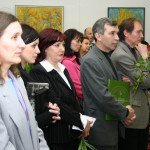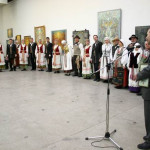Exhibition “Gates of the Earth” V. Kašinskas retrospective exhibition “Gates of the Earth” National M. K. Čiurlionis Art Museum Kaunas picture gallery, K. Donelaičio str. 16 Exhibition program: March 5, 2005 (Saturday) at 2 p.m. Participates in: 1. Domeikava Cultural Center Mixed Choir ‘VERSMĖ’. Manager – Rasa Endriukaitė, concertmaster – Rimvydas Kruopis 2. Raudondvaris cultural center, modern dance group “AUKŠTYN” Director Jolanta Zizienė 3. Kaunas J. Naujalis Music Gymnasium. Mantas Savickis (piano) will perform his musical compositions and improvisations. 4. Meeting of the author of the exhibition with the audience. V. Kašinskas will present and comment on his works to the visitors of the exhibition and tales about Lithuanian mythology. Program director and head of the Culture, Education and Sports Department of the Kaunas district. specialist Birutė Savickienė. March 12, 2005 (Saturday) at 2 p.m. Participates in: 1. Concert Folklore Ensemble “KUPOLĖ” Conductor Antanas Bernatonis 2. Meeting of the author of the exhibition with the audience. V. Kašinskas will present and comment on his works to the visitors of the exhibition and tales about Lithuanian mythology. Program director and head of the Culture, Education and Sports Department of the Kaunas district. specialist Birutė Savickienė. Closing of the exhibition March 19, 2005 (Saturday) at 2 p.m. Participates in: 1. “VYTURIO” mid-year mixed youth choir. Manager – Rinalda Burinskienė 2. J. Gruodis Conservatory folk instrument orchestra. Manager Irena Vaitkevičiūtė 3. Kaunas J. Naujalis Music Gymnasium. Mantas Savickis (piano) will perform his musical compositions and improvisations. Dainius Veršulis (cello). 4. Meeting of the author of the exhibition with the audience. V. Kašinskas will present and comment on his works to the visitors of the exhibition and tales about Lithuanian mythology. Program director and head of the Culture, Education and Sports Department of the Kaunas district. specialist Birutė Savickienė. Additional information: mobile. tel. +370 614 05293, e-mail p.: virginijus.kasinskas@gmail.com
The exhibition features a collection of 70 paintings on the theme of Lithuanian mythology from four painting cycles: “Gates of the Earth”, “Lamentations”, “Archaic Compositions” and “Cosmogonies”. According to art researcher Saulius Mikėnas, all exhibition cycles have one goal in common – to reveal the essential spiritual elements of our being, to show their forms of manifestation, connections and dynamism. The cycle “Lamentations” was inspired by the analysis and empathy of our national culture, the cycle “Gates of the Earth” is based on the study of mythological material. The last cycles “Archaic compositions”, “Cosmogonic compositions” are searches for basic, universal constructions of being. Themes and methods of solution allow us to attribute the artist to the eternal symbolic direction of painting. V. Kašinskas 1981-87 studied and graduated from the Vilnius Art Institute (now the Academy of Fine Arts) majoring in painting. Since 1992 Member of the Union of Lithuanian Artists. Participates in exhibitions since 1987. The artist has organized 43 personal exhibitions of paintings, drawings and photography in Lithuania and abroad. He participated in several art auctions where his paintings were purchased. His works have been acquired by Lithuanian museums, art fans and collectors from Lithuania, Poland, Russia, Germany, USA, France, Luxembourg, Denmark and Israel. During the opening of the exhibition, the folklore ensemble “Viešia” (conductor J. Balnytė), the folk dance group “Kupolios rožė” (conductor B. Savickienė), the village chapel “Vilkynė” (conductor G. Normantienė), the Kaunas J. Naujalio music high school. Mantas Savickis will perform musical compositions and improvisations. The program will be hosted by Birutė Savickienė. V. Kašinskas plans to hold meetings with the audience every Saturday until his exhibition takes place (March 5, 12, 19 at 2 p.m.). The artist will present and comment on his works to the visitors of the exhibition and tell about Lithuanian mythology. During the meetings, folklore ensembles will illustrate and complement the author’s stories. The exhibition will be open: 26.02.2005-20.03.2005
Virginijas Kašinskas’ retrospective annotation of the painting exhibition “Gates of Earth”.
Virginijus Kašinskas is one of the most original contemporary Lithuanian artists. In the exhibition organized on the occasion of the artist’s 50th anniversary, we can see the most significant part of the painter’s creative biography. A large overview exposition provides an opportunity to clearly define the author’s focus area, i.e. to see the most significant themes, objects, to understand the complexity of the problems solved by the artist. But the most important thing is the opportunity to feel the specificity of its plastic.
The basis of the exhibition is the cycles of paintings. The gradual, consistent and as complete as possible disclosure of the topic is related in this case to the importance of the objects, the desire to convey them in a constant change, a specific rhythm of time and space. I think that this way of presentation also came about because of one of V. Kašinska’s essential qualities – the artist’s honesty. As a rule, the plastic solution of an important topic is accompanied by careful preparatory work of the author. At the beginning – drawings, sketches, special photography of individual details, on-site research of historical objects (including the Holy Land), study of literature on a given topic. Later – synthesis and practical implementation. All exhibition cycles are united by one goal – to reveal the essential spiritual elements of our being, to show their forms of manifestation, connections and dynamism.
One of the artist’s earlier cycles “Raudos” was inspired by the analysis and empathy of our national culture. The most archaic layer that survived in the artist’s native Žemaitia helped the author to highlight its metaphysical content. The theme of mourning has existed in painting for thousands of years. Since the beginning of civilization, artists began to immortalize the rituals accompanying the loss of a person with special compositions. V. Kašinska’s cycle uniquely reveals the problem of human existence, death and further transformation of his being. The means of artistic expression used by the author are the least influenced by various styles of folk art. The figures of people in the paintings are like the folk sculptures of Žemaitsi – generalized and geometrized, sometimes even losing signs of age and gender. The impression of the universality of the action is accentuated by the conditional environment. It is not an earthly, objective world, but a realm of sorrow and hope experienced through feelings. The impression of the eternity and universality of the action immersed in a unified, restrained color atmosphere is enhanced by the permeation and repetition of spatial plans and forms. The dynamics are
not only for the figural composition layer. The impression of movement towards the viewer’s space is conveyed by the vibration of the painting surface created by the paint relief, the opposite direction is conveyed by the linear drawing that almost reaches the ground. Gradually, the rhythmicity covering the whole image helps to form the author’s vision of a more durable structure.
The artist continued his search for basic, universal constructions of being in the “Gate of the Earth” cycle based on studies of mythological material. It began a new plastic search for archetypal models of world perception. As a true symbolist, the artist used various stylistics – realistic, expressionist, surrealist. In order to control the dynamics of numerous forms and bright colors, the author began to compose paintings with a strict geometric structure more often. All shapes and colors are intended to give symbolic meaning.
Consistently searching for the main constructions, rejecting secondary elements and details, V. Kašinskas gradually gave up figurative images. The cycle “Archaic compositions” visually already resembles geometric abstraction. The compositional, linear and color structures used by the author are an artistic reconstruction of the ancient Baltic ornamental code that conveys the order of the world. Through the complex construction, door or window motifs sometimes shine through, the combinations of Žemati colors ring out. Some of the works in this cycle are very complex. These are compositions of the spheres of the universe, the solar system, the tree of life, based on the symbolism of geometrized shapes, colors and numbers. The artist added various protection signs to the deep structures. When observing the image for a longer period of time, the elements in the planes may begin to optically change. They are like synthetic objects of art, science and faith.
The last cycle of such stylistics is “Cosmogonic compositions”. These works direct our gaze to the universe – where the great superstructure emerges. Harmonious galactic mirages unfold in the cycle. And then it turns out that the author is not alone on this path. The so-called ornamental Roman mosaics, the vault mosaics of the Mausoleum of Gallia Placidia in Ravenna, or the stained-glass windows of the Rose of Chartres Cathedral glow in a similar way.
Let’s hope that such a direction of painting will be viable after us.
Art critic Saulius Mikėnas








